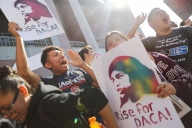You have /5 articles left.
Sign up for a free account or log in.
A pilot program that eases federal financial aid rules for some distance education providers has significantly improved access to higher education for students generally, and for financially needy students in particular, according to a new U.S. Education Department report.
The findings led the department -- and Republican leaders in Congress -- to urge abandonment of financial aid restrictions on distance education, a change that many higher education lobbyists oppose.
The Education Department offered its findings in its third annual report to Congress on the Distance Education Demonstration Program, which Congress created when it renewed the Higher Education Act in 1998.
Among other things, the program waives for participating institutions a regulation that bars from federal financial aid programs colleges that (1) offer more than half their courses via distance education or (2) enroll more than half of their students in online programs. The regulation, known as the "50 percent rule," was drafted in 1992 to rein in the rapid growth of fraudulent diploma mills and correspondence schools.
The demonstration program now includes 24 colleges: nine for-profit institutions, including five publicly traded ones; seven private nonprofit institutions; four public universities and one public system; and three consortiums. (Another four participants have left the program voluntarily and one, Masters Institute, was removed after it was found to have "improperly" administered federal aid funds, the department said.)
The participating institutions have seen heavy increases in their online enrollments, the department's report finds.
The eight colleges from the original group of institutions that have reported data for six years -- including Kaplan University, the North Dakota University System, Southern Christian University and the University of Maryland University College -- had total distance education enrollment of 63,350 in 2003-4, up from 7,930 in 1998-99. Seven other colleges that entered the program in 2000 and have reported enrollment data since then -- including Regis University, the University of Phoenix and Walden University -- grew to 223,404 online students in 2003-4 from 45,997 in 2000-1.
And the students being enrolled by these distance education institutions, the department reports, are heavily nontraditional and financially needy:
- Of the seven biggest institutions in the program -- those with more than 5,000 students -- five reported having more than half of their students qualify for federal financial aid in 2003-4. They are American InterContinental University (76 percent), Capella University (68 percent) Kaplan University (79 percent), Phoenix (68 percent) and Walden (56 percent).
- In 2002-3, more than a quarter of the participating institutions had a majority of their students aged 35-44, and at more than half of the colleges, the majority were aged 25-34.
- At four-fifths of the participating colleges, at least 60 percent of the students study part-time.
- Several of the institutions reported significant enrollments of minority students. Capella University and Southern Christian University both reported that nearly a third of their students are members of minority groups, and the University of Maryland University College reported 53 percent of its undergraduate distance education students are minorities, and that a third are African-American.
The department's report recommends that Congress expand the program to include 100 institutions (it is now capped at 35) and give the education secretary authority to allow institutions to experiment, and deviate from federal rules, even more. It also recommends that when it renews the Higher Education Act -- either this year or, more likely, next -- Congress abolish the 50 percent rule for both the number of courses that can be offered and students that can be educated via distance education.
In a news release about the Education Department's report, Republican leaders of the House of Representatives Education and the Workforce Committee agreed. "Some of America's most vulnerable students are being deprived of a postsecondary education as a result of outdated laws that govern distance education," said Rep. Howard P. (Buck) McKeon (R-Cal.), who heads the House panel's higher education subcommittee, said. "These laws are completely out of touch with the needs of the 21st century student."
Officials at the major higher education associations don't disagree with the Education Department and Republican House leaders that the distance education project has been a success, and that the department should continue to waive federal financial aid regulations, including the 50 percent rule, for credible colleges. In fact, in the joint proposal for extending the Higher Education Act that they prepared in 2003, about three dozen college groups encouraged Congress to turn the Distance Education Demonstration Program into a permanent one.
But just because the program has been successful does not mean that Congress should abandon the 50 percent rule altogether, Becky Timmons, director of government relations at the American Council of Education, said in an interview Tuesday.
"One enormous opportunity for abuse in distance education is rapid expansion," said Timmons. Right now, she said, "anybody who wants to go above 50 percent can with a waiver from the department, and we think that's wise. It ensures an extra level of supervision by the department, but doesn't stop anybody who has an authentic program to go above" that threshold.









